Abstract
The primary objective of this paper is to establish precisely how and which biomechanical parameters explain and define the initial vault value. The study sample includes 64 vaults as per the Code of Points of the International Gymnastics Federation (FIG). The sample of dependent variables includes all points ranging from 2 points to 7.2 points, while the sample of independent variables includes 12 biomechanical variables expressed in various measure units. All data were analysed using SPSS Statistics 17.0. With regression analysis we explained 92.4% of the difficulty vault value. Only three biomechanic variables were predictors: degrees of turns around transversal axis, degrees of turns around longitudinal axis and body’s moment of inertia around transversal axis in the second flight phase. Factor analysis has resulted in isolating the following four factors: degrees of turns around transversal axis in the second flight phase, first flight phase, longitudinal body axis in the second flight phase, and the support on the table. The results of the research may serve as a starting point for launching an initiative for changing the FIG rules on awarding points in relation to the existing Code of Points (2009). This type of research has confirmed that, from a biomechanical point of view, initial vault values can be far more realistically determined by the expert panel of the men’s FIG technical committee.


